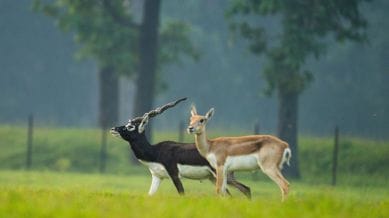Stay updated with the latest - Click here to follow us on Instagram
It went locally extinct for 50 years. Then, the blackbuck made a miraculous comeback in Chhattisgarh’s Barnawapara sanctuary
Poaching, habitat loss, and human encroachment drove the blackbuck population down, with the state declaring it locally extinct in 2017. That changed when the state came up with a five-year revival plan.

In 2018, officials at Chhattisgarh’s Barnawapara Wildlife Sanctuary embarked on an ambitious venture: to revive the blackbuck population 50 years after it had become “locally extinct”. It was a gamble: the habitat loss, human encroachment and forest fragmentation that contributed to the animal’s erasure from the state still existed, and officials were unsure if their efforts would pay off. They did – Barnawapara now boasts 190 blackbucks, and officials plan to replicate the conservation model across the state.
Over the last five years, the Chhattisgarh government has successfully reintroduced the blackbuck – a graceful medium-sized antelope that inhabits open grasslands of India and Nepal – back into the state’s forests through its five-year reintroduction plan. Once found in Barnawapara in Balodabazar district, the blackbuck is listed among endangered species under Schedule I of the Wildlife Protection Act, 1972.
As part of the 2021–2026 revival plan, the Chhattisgarh State Wildlife Board translocated 77 blackbucks – 50 from the National Zoological Park in New Delhi and 27 from the Kanan Pendari Zoological Garden, Bilaspur. The move paid off.
“Once found abundantly across India, blackbuck populations have dramatically declined over the last few decades due to habitat loss and human pressures. In Chhattisgarh, this species had completely disappeared by the 1970s and remained locally extinct for nearly 50 years,” a senior official said. “However, a new chapter began in 2018, when the Chhattisgarh state Forest Department initiated a historic reintroduction program in Barnawapara Wildlife Sanctuary.”
Dhammsheel Ganveer, the Balodabazar divisional forest officer, said: “The sight of males, with their deep black coats and striking horns, leading herds across Chhattisgarh’s open meadows was once lost but has now been restored, all thanks to the dedication, hard work and constant vigilance of the entire team at the sanctuary.”
According to the Raipur Forest Division’s Working Plan – a document outlining forest management activities – blackbucks were found in Balodabazar in the 1970s. But rampant poaching, infrastructure development and encroachment on grassland areas caused their population to crash, leading to their being declared “locally extinct” – that is, disappearing completely from Chhattisgarh.
That changed after a meeting of the state wildlife board in 2018. Soon, the board brought in 19 males and 50 females into the sanctuary – first keeping the animals in enclosures for up to two years before releasing them into the wild.
According to officials, the forest department has so far released 100 animals into the wild while 90 remain in enclosures and will eventually be released.
It wasn’t without setbacks. Officials admit that the first two years were challenging, with eight blackbucks dying in a pneumonia outbreak.
After this, the department took measures to steady the course. In the short term, it sand-layered the enclosure to keep it dry, improved drainage and waste disposal, and appointed an on-call veterinary doctor. In the long term, it formed a dedicated conservation team for habitat management, nutrition and monitoring.
“This includes Rampur grasslands where attention was paid to weed removal while palatable grass species were promoted. Patrolling camps were set up for continuous monitoring and cameras installed for real-time tracking. Watchtowers were built for surveillance against poachers, and regular foot patrols were carried out by forest employees to prevent poaching,” Balodabazar Divisional Forest Officer Dhammsheel Ganveer said.
Following the success in Barnawapara, the forest department is now drawing up plans to reintroduce the animal in sanctuaries with open grasslands such as Gomardha Wildlife Sanctuary.
“It’s one of the best sanctuaries we have because of its good topography and beautiful landscape,” said Arun Kumar Pandey, principal chief conservator of forests (Wildlife) and chief wildlife warden.